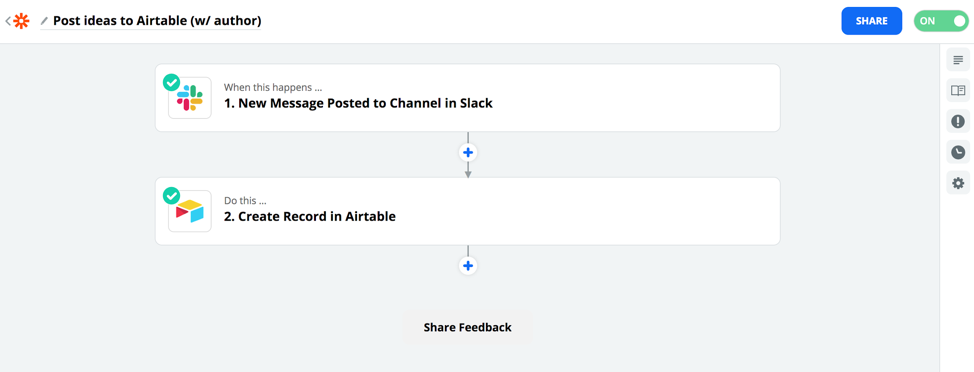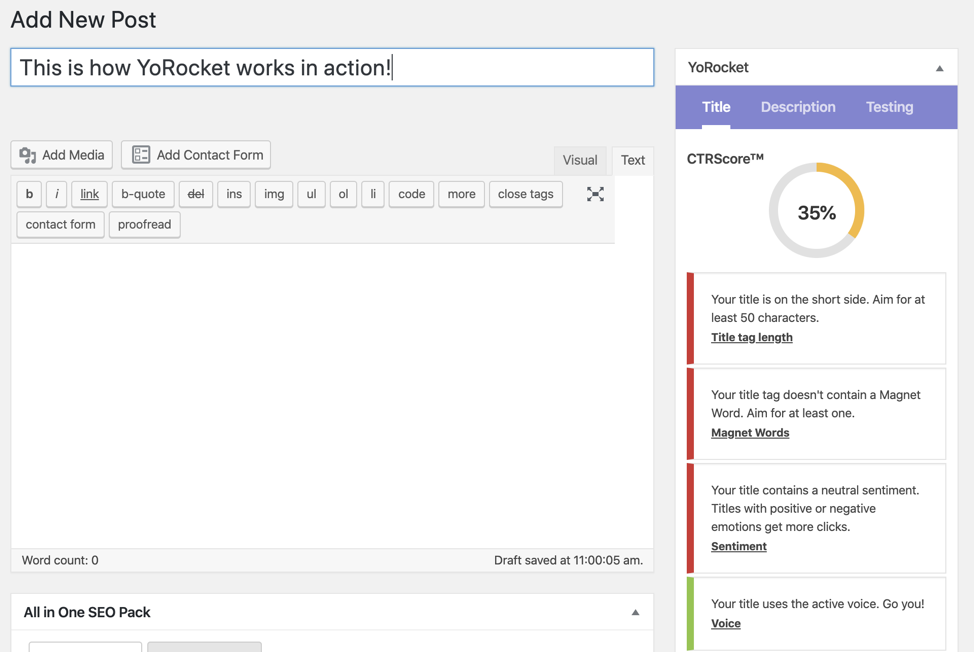 A few years ago, I didn’t think creating more than two high-quality posts in a week was possible.
A few years ago, I didn’t think creating more than two high-quality posts in a week was possible.
Why?
Because the way we went about it slowed us down. We had no central repository for ideas, no formulaic way to tackle posts, and no step-by-step editing checklist for getting rid of pesky mistakes.
But that changed when we armed the team with automations, hotkey-based productivity apps, and checklists. Productivity rose without sacrificing quality.
Let me explain the process and helpful tools we use now.
HANDPICKED RELATED CONTENT:
Collect and vet ideas: Slack, Zapier, and Airtable
Greenwashing. Work anxiety. ISO 9001. Every day, there’s a new topic a team member wants to write about. We capture these suggestions on an internal Slack channel called “mkt-post-ideas.”
Anyone with an idea can post it to the channel:

If keyword research was involved, the person posting the ideas includes the numbers – volume, keyword difficulty, and sometimes cost per click:

The suggestions aren’t just recorded on Slack. We use Zapier to push the ideas automatically to the project management tool, Airtable.
Zapier is a software integration platform that lets you build nifty automations known as “Zaps” to connect applications. No coding experience required.
We push the ideas from Slack to Airtable so they’re easy to access for our sprint planning. When we’re ready to allocate work to the writers, the idea cards are waiting.
To set up a handy Zap between Slack and Airtable:
- Create a free Zapier account.
- Hit the “Make a Zap!” button.
- Choose Slack as the first app.
- Select “New Message Posted to Channel” as the trigger. Then select the appropriate Slack channel.
- Choose Airtable as the second app.
- Select “Create Record” as the action, then customize it to how you want the record/card to appear.

HANDPICKED RELATED CONTENT:
Research: Ahrefs
Once a writer is assigned to a card (i.e., the topic), the final keyword research process begins.
To get a slice of the SERP pie, the content must include relevant keywords, including long-tail phrases. We use Ahrefs for keyword research.
I won’t flesh out every step of the research checklist, but the core components include:
- Create a spreadsheet and record initial post details (subject matter, Airtable record, and link for Ahrefs results that will be copied and pasted later).
- Paste at least five links to articles we’ve read on the subject.
- Document initial thoughts for keywords/terminology.
- Note Google’s recommendations for suggested keywords.
- Run a 20-plus keyword list through Ahrefs.
- Paste the Ahrefs results for “all,” “have same terms for,” “phrase match,” and “also rank for” search options onto the spreadsheet.
- Add a column for the best keyword options.
- Whittle the Ahrefs results to one keyword and three to four related long-tail words for the newly created best column.
- Get approval to proceed to content creation.
Frankly, the keyword research process can be daunting. It takes time to nail down the set of keywords and long-tail words you’re going to use. But it’s a necessary process.
#Keyword research can be daunting, but it’s necessary in the #content production process, says @thomjamescarter via @cmicontent. Click To TweetHANDPICKED RELATED CONTENT:
Creation via collaboration: YoRocket and Polly
With the idea and keywords approved – and feedback received – it’s time to move to the blog-post production checklist.
The first step is to brainstorm five unique headlines for the post. To ensure that those titles grab attention, demonstrate value, and steer clear of clickbait territory, we use two tools: YoRocket and Polly.
Note: YoRocket is no longer available (although if you’ve already installed it you can still use it). You can try Yoast (which is similar) or CoSchedule’s Headline Analyzer if you don’t have access to YoRocket.
YoRocket is a WordPress plug-in that dynamically provides CTR (click-through rate) projections based on a title. It produces near-instant results to see if the title meets best practices (e.g., 130 to 150 characters, inclusion of magnet word, use of brackets). YoRocket has a slightly adverse effect on page load times. That’s not ideal, but the pros usually outweigh the cons.

The writer shares the five titles with the team through Polly, a poll and survey plug-in for Slack. The poll results help the writer know which titles the team prefers. Asking for opinions is a nifty discussion starter as colleagues chime in with suggestions on how to improve the titles.
A poll plug-in for @SlackHQ, @polly_ai engages the #content team in picking the best headline, says @thomjamescarter via @cmicontent. #tools Click To Tweet
By this point, the foundation for the post is set. The next course of action is to get the creative juices flowing and start writing the thing.
Structure: Alfred
Our articles follow a standard format: Each includes intro links (also known as a table of contents or bookmarks) at the top so the reader can click to go directly to that section of the page. It takes some fiddling with HTML inside WordPress to set this up.
Alfred helps us accomplish that. Among its many features, Alfred lets users create defined “hotkeys” to launch snippets for text expansion. We set it up to connect the subheads to the intro link text and the intro link text to the subheads.

This method not only makes reading easier for the audience, it also gives the article a solid structure that can aid in the writing process. That’s a two-birds-one-stone example if I’ve ever seen one.
Review: Slack
Turning great writing into stellar content takes more than one pair of eyes. That’s why we do a peer review for every post. It bolsters the content quality and facilitates communication among our content team members, who work in Scotland, England, Wales, Spain, Canada, and the United States.
To turn great #writing into stellar #content, a peer review is needed, says @thomjamescarter via @cmicontent. Click To TweetWhen a first draft is ready, another writer is automatically notified and jumps on the peer review.

The reviewer follows a 12-point checklist:
- Is it unique?
- Is it actionable?
- Is it interesting?
- Is it well sourced?
- Does it explain the product?
- Does it show off all the features it can?
- Is it concise?
- Does it include an embedded template?
- Could the structure be improved?
- Is it in American English? (And is the spelling, grammar, etc., up to scratch?)
- Does it meet the keyword intent?
- Could it capture long-tails better?
A peer review for a 3,000- to 5,000-word article takes me about 30 to 45 minutes. Writing my notes for the author usually takes five minutes.
The notes are automatically pushed through another Zap to a dedicated Slack channel – content-peer-review – for the writer to review. The writer updates the draft.
HANPICKED RELATED CONTENT:
Editing
An editor is automatically notified when the writer’s revised draft is ready. This person follows another checklist to ensure that the post is 100% ready for publishing. The editor is prompted to:
- Read the post aloud. This step is an incredibly effective (and simple) way to notice any issues with written text.
- Assess HTML formatting. Even if HTML looks correct at a glance, formatting mistakes can exist, whether it’s accidentally coding in extra spaces on the page or leaving out an angle bracket, which could create havoc. (To make the editors’ jobs easier, create snippets for HTML in Alfred so the standard HTML in the posts in WordPress is always correct.)
- Check post configuration. Make sure the post’s categories (e.g., productivity, business, marketing, management), tags (i.e., keyword, relevant long-tails, keyword variations), and SEO meta descriptions are accurate. (We use YoRocket to evaluate the viability of our meta descriptions. We then paste the meta description into an SEO description box provided by the All in One SEO Pack WordPress plug-in.)
Once the final review is complete, the post is scheduled for publishing.
Be agile
This process serves us well, but we didn’t just stumble upon it. It’s taken constant tweaking and reiterations to arrive at this point.
Whether you follow this process or go a different way, remember that your content production process is always in flux. New tech arrives and old tools no longer work. New content-related best practices appear and others become irrelevant.
But that isn’t a negative. By regularly tinkering with the tasks and tools involved in the content creation process, you can keep the process optimized and agile.
Please note: All tools included in this post are suggested by the author, not the CMI editorial team. No one post can provide all relevant tools in the space. Feel free to include additional tools (from your company or ones you’ve used in the comments).
Part of being agile and continually improving your content production process is education. Join us to learn the latest best practices, helpful tips, and more at Content Marketing World this October. Register today for the best rates.
Cover image by Joseph Kalinowski/Content Marketing Institute

